By: Dr. Elizabeth Eggert

‘Tis the season for giving. Give to the Max Day, Giving Tuesday, and the red kettles of the Salvation Army all ring in the holiday season. Presents arrive in the mail and under the tree. We hope our giving and volunteering benefit others, but did you know there’s scientific evidence that our giving and volunteering help us, too?
Giving Makes Us Feel Good
Over the past decade, scientific studies have found that the act of giving makes us feel better. In 2008, Harvard Business School researchers found that spending money on others makes us happier than spending money on ourselves. Giving decreases our stress and makes us feel closer to the recipients of our giving (and vice versa).
What’s more, the simple act of giving can have ripple effects. Not only does giving make us feel better, it makes our recipients feel better and more inclined to give. Our giving is passed down to others, which increases our feeling of connectedness and even promotes more cooperation.
At Eggert Family Dentistry, we are happy to contribute to the local scholarship funds of four local high schools each year: Mounds View, Irondale, Centennial, and Spring Lake Park (Dr. Elizabeth and Dr. Jeff’s alma mater). Since 2004, we have contributed over $25,000 to deserving students.
Volunteering Has Health Benefits, Too
Other research has looked into the health benefits of volunteering our time. It turns out that volunteering can improve our health, too. Serving others can lower our blood pressure and decrease depression. The social interaction we experience when we volunteer releases dopamine, a chemical in our brain that makes us happier.
One study of the health effects of volunteering found that elderly people who volunteer at two or more organizations were 44 percent less likely to die over a five-year period, despite their age or exercise and other wellness habits. Even the federal government is examining the health benefits of volunteering. You can read its comprehensive report here.
Our team felt really good about volunteering at Feed My Starving Children this year. It is great to know we all can make a difference.
To stay healthy this holiday season, eat moderately, exercise regularly, and make giving and volunteering part of your routine. And don’t forget your regular dental appointments! Schedule your next visit to Eggert Family Dentistry today.









 When Dr. Elizabeth noticed crowding on her lower anterior teeth and wear on some of her teeth due to malalignment, she knew Invisalign® would be a good option for her. The system of clear, comfortable, plastic aligners would gradually bring her teeth into alignment
When Dr. Elizabeth noticed crowding on her lower anterior teeth and wear on some of her teeth due to malalignment, she knew Invisalign® would be a good option for her. The system of clear, comfortable, plastic aligners would gradually bring her teeth into alignment 

